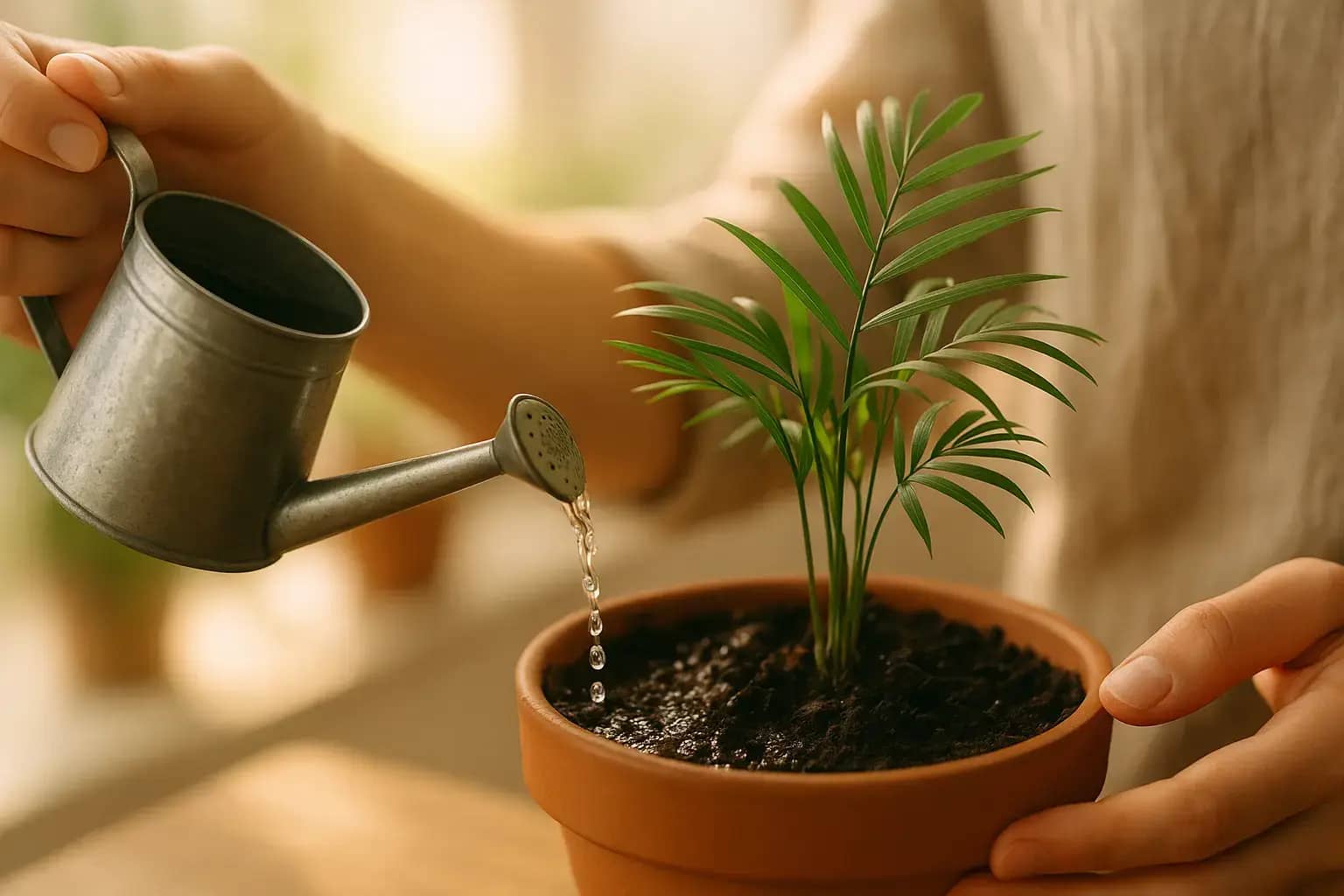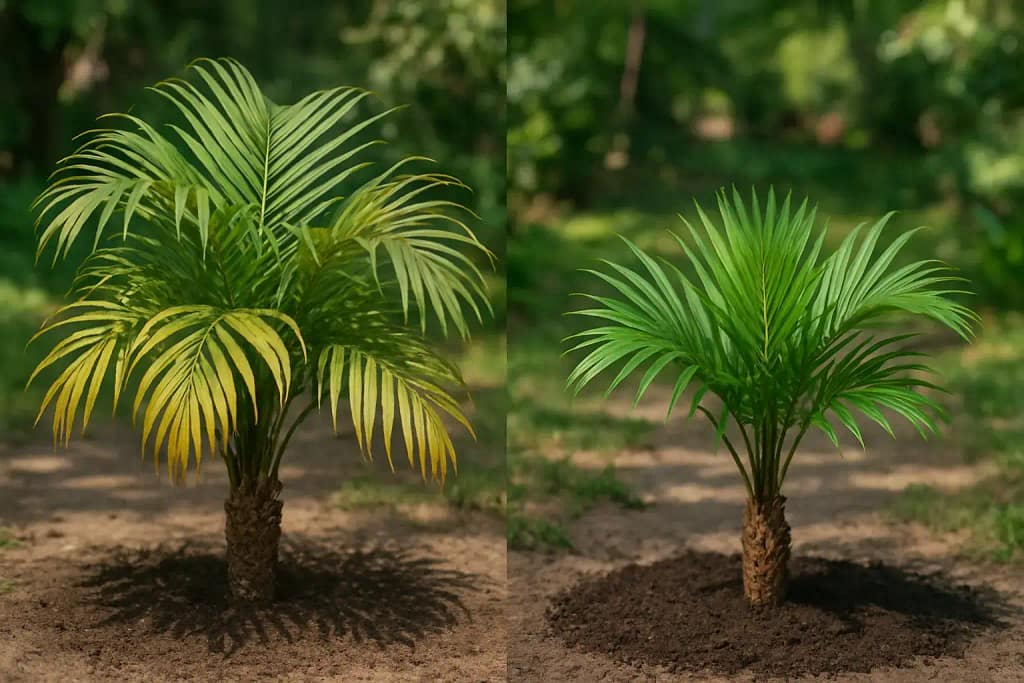
Mini Palm Tree Care Guide: How to Plant, Water, Trim, and Troubleshoot
Mini palm trees have a certain charm, don’t they? They’re like the chill friend who never asks for much but always shows up looking effortlessly cool. Whether you’ve got one tucked into a cozy corner of your living room or basking on your sunny patio, knowing how to care for a mini palm tree can keep that tropical vibe strong all year round.
Let’s break down the essentials from planting to trimming, watering to “uh-oh, why is my mini palm tree turning yellow?” we’re covering all the good stuff.
How to Care for a Mini Palm Tree (Without Losing Your Mind)

So, how to care for a mini palm tree? It starts with one key word: balance. These little guys don’t ask for extravagant routines, but they do need consistency. Think Goldilocks is nothing too extreme.
- Light: Bright, indirect sunlight is the sweet spot. A south-facing window works wonders indoors. Outdoors? Partial shade is your best friend.
- Temperature: They like it warm ideally between 65°F and 80°F. Keep them away from chilly drafts or vents blasting hot air.
- Soil: Well-draining potting mix is non-negotiable. Use soil designed for palms or cacti to avoid soggy roots.
- Humidity: While they’re not divas, mini palms do appreciate some moisture in the air especially in winter when heating systems suck the life out of your home. A pebble tray or small humidifier can make a difference.
The truth is, once you get the basics down, caring for a mini palm becomes more of a calming ritual than a chore. Like watering a bonsai or polishing your favorite boots routine, but satisfying.
How to Plant a Mini Palm Tree (And Not Kill It in the Process)
Now, let’s talk about planting. You bought a cute mini palm from the garden center, it came in a plastic pot, and you’re thinking, “Cool, now what?”
Here’s how to plant a mini palm tree without making rookie mistakes:
- Pick the right pot: Go for one with drainage holes. Trust me, root rot is a silent killer.
- Layer up: Add a few pebbles or broken terra cotta at the bottom for airflow.
- Soil matters: Use that well-draining mix we talked about earlier. Bonus if it contains perlite or sand.
- Settle it in: Position the palm in the center, fill around with soil, and gently pat it down. Don’t press too hard; you want the roots to breathe.
- Water it in: Give it a light soak to help the soil settle, then let it drain completely.
And a quick note here: don’t repot unless you really need to. Mini palms prefer being a little root-bound. You can wait until roots are visibly poking out of the drainage holes before moving them to a bigger home.
How to Trim Mini Palm Trees (A Little Off the Top, Please)
Ah yes, trimming. One of those things that sounds simple but makes you second-guess yourself when you’re actually holding the shears. The good news? Knowing how to trim mini palm trees is mostly about knowing what not to do.
You don’t want to go Edward Scissorhands on your plant.
- Trim only dead or yellowing fronds. These won’t magically green up again, and they can steal energy from healthy growth.
- Use clean, sharp scissors or pruning shears. This reduces the risk of infection.
- Cut close to the base but not flush. Leave a small nub to avoid damage.
- Don’t trim green fronds. Even if they’re not perfectly shaped, they’re still photosynthesizing and helping the plant thrive.
Regular trimming isn’t mandatory mini palms aren’t high-maintenance that way. Once every few months is plenty, or just as needed. Honestly, trimming mini palm trees is more about aesthetics than health, so don’t stress it.
How Big Does a Mini Palm Tree Get? (Spoiler: It’s in the Name)

You’d think the word “mini” says it all but let’s be honest, plant labels can be sneaky. So how big does a mini palm tree get, really?
Well, it depends on the type. Some common varieties:
- Parlor Palm (Chamaedorea elegans): Usually tops out around 2 to 4 feet indoors.
- Pygmy Date Palm (Phoenix roebelenii): Outdoors, it might reach 6 feet but kept in a container, it’ll stay smaller.
- Cat Palm (Chamaedorea cataractarum): Grows bushier, around 3 to 5 feet tall, depending on conditions.
The cool thing? Mini palms are pretty forgiving. You can control their size with pruning and pot size just like how a goldfish won’t outgrow its tank, a mini palm in a small pot will grow more slowly.
How Long Does Mini Palm Tree Take to Grow? (Patience Is a Virtue, Folks)
Alright, now for the million-dollar question: how long does mini palm tree take to grow? Let’s just say… it’s not a race.
Mini palm trees are slow growers by nature. From seed, it could take several months just to see a couple inches of growth. Most folks skip the seed stage altogether and start with young plants. Even then, expect:
- First year: A few new fronds, modest height increase.
- After 2–3 years: Noticeable shape and a fuller appearance.
- 5+ years: Maturity! Well, for the plant at least.
If you’re after instant gratification, a mini palm might test your patience. But if you’re someone who enjoys watching life unfold slowly like sourdough starters or vintage wines this little tree is for you.
How Much Water Does a Mini Palm Tree Need? (Not Too Much, Not Too Little…)

Let’s talk about hydration because figuring out how much water does a mini palm tree needs can feel like guesswork. But it doesn’t have to.
Mini palm trees like their soil like a well-wrung sponge: moist, but not soaked. If you overdo the watering, those roots can end up drowning. Too little, and the fronds start looking crispy and sad.
Here’s a good rule of thumb:
- Poke your finger into the dirt, roughly an inch down, to check for moisture.
- If it feels dry? Time to water.
- Still damp? Wait a day or two.
During warmer months, your mini palm may need water once or twice a week. When things cool down in fall and winter, they’ll need less, maybe every 10 days or so. (Think of it like switching from iced coffee to hot tea, same drinker, different vibe.)
Also, make sure excess water drains out completely. No one likes wet feet, and your palm agrees.
How Often Do You Water a Mini Palm Tree? (Timing Is Everything)
Now, if you’re wondering how often to water a mini palm tree, you’re not alone it goes hand in hand with the last point. Well, it depends on where it’s living and what it’s living in.
Indoors, with filtered light and a dry heating system? You might water every 5–7 days in spring and summer. Outdoors, especially in a humid region or during a rainy spell, it could stretch longer.
But here’s the kicker: don’t follow a rigid schedule. Let the soil and your plant’s mood guide you.
Some quick watering tips:
- Water in the morning so the soil has time to dry before cooler evening temps set in.
- Avoid cold water, it can give the roots a bit of a shock they won’t appreciate.
- Try not to splash the leaves, especially if your plant’s in a sunny spot. It can lead to spotting or scorching.
To be real, it’s not an exact science, it’s more about paying attention and adjusting as you go. Get to know your plant like you would a pet, watch its behavior and adjust accordingly.
Why Is My Mini Palm Tree Turning Yellow? (Cue the Plant Panic)
Okay, so everything was fine, and then one morning you ask yourself why is my mini palm tree turning yellow?
Don’t panic. Yellowing leaves are your palm’s way of saying, “Hey, something’s off.” It’s not mad at you; it just needs a little help.
Let’s troubleshoot the common culprits:
- Overwatering – This is the #1 offender. Too much moisture means the roots can’t breathe, which often leads to yellowing leaves near the base.
- Underwatering – On the flip side, long dry spells can dry out fronds. The tips turn yellow or brown.
- Nutrient Deficiency – Lack of magnesium or potassium can cause yellowing. A palm-specific fertilizer every few months can work wonders.
- Poor Drainage – Even if you’re not overwatering, compacted or waterlogged soil can suffocate the roots.
- Pests – Spider mites, mealybugs, or scale insects might be lurking. Check under the leaves for tiny intruders.
Here’s what to do:
Trim the affected leaves if they’re fully yellow. Adjust your watering. Maybe report. Give it a light feed. And wait. Palms bounce back slowly, but they do bounce back.
Honestly, yellowing leaves are like the check engine light on your dashboard. It doesn’t always mean disaster, but it does mean it’s time to pay attention.
Wrapping It All Up (Your Mini Palm’s Happily Ever After)
So, let’s bring it home.
Learning how to care for a mini palm tree isn’t about following some complicated horticultural handbook. It’s about forming a relationship with a living thing knowing when it needs a drink, a haircut, or a moment of peace in a sunny spot.
From how to plant a mini palm tree to knowing how to trim mini palm trees the right way, you’ve got the basics down. You understand how big does a mini palm tree get (not that big, thankfully), and you’re probably more patient now that you know how long does mini palm tree take to grow (hint: slowly, but steadily).
You’ve figured out how much water does a mini palm tree need and how often do you water a mini palm tree without stressing over it. And most importantly, if you ever find yourself asking, “why is my mini palm tree turning yellow?” you’ll know exactly where to start looking.
And that’s really the secret to plant care: not perfection, just awareness.
Give it a little attention, keep things consistent, and enjoy the small signs of life and growth. That mini palm? It’s not just a decoration it’s a quiet, leafy reminder to slow down and stay grounded.
Got more plant questions? Drop them in the comments or shoot us a message. We love talking about green stuff. 🌿



